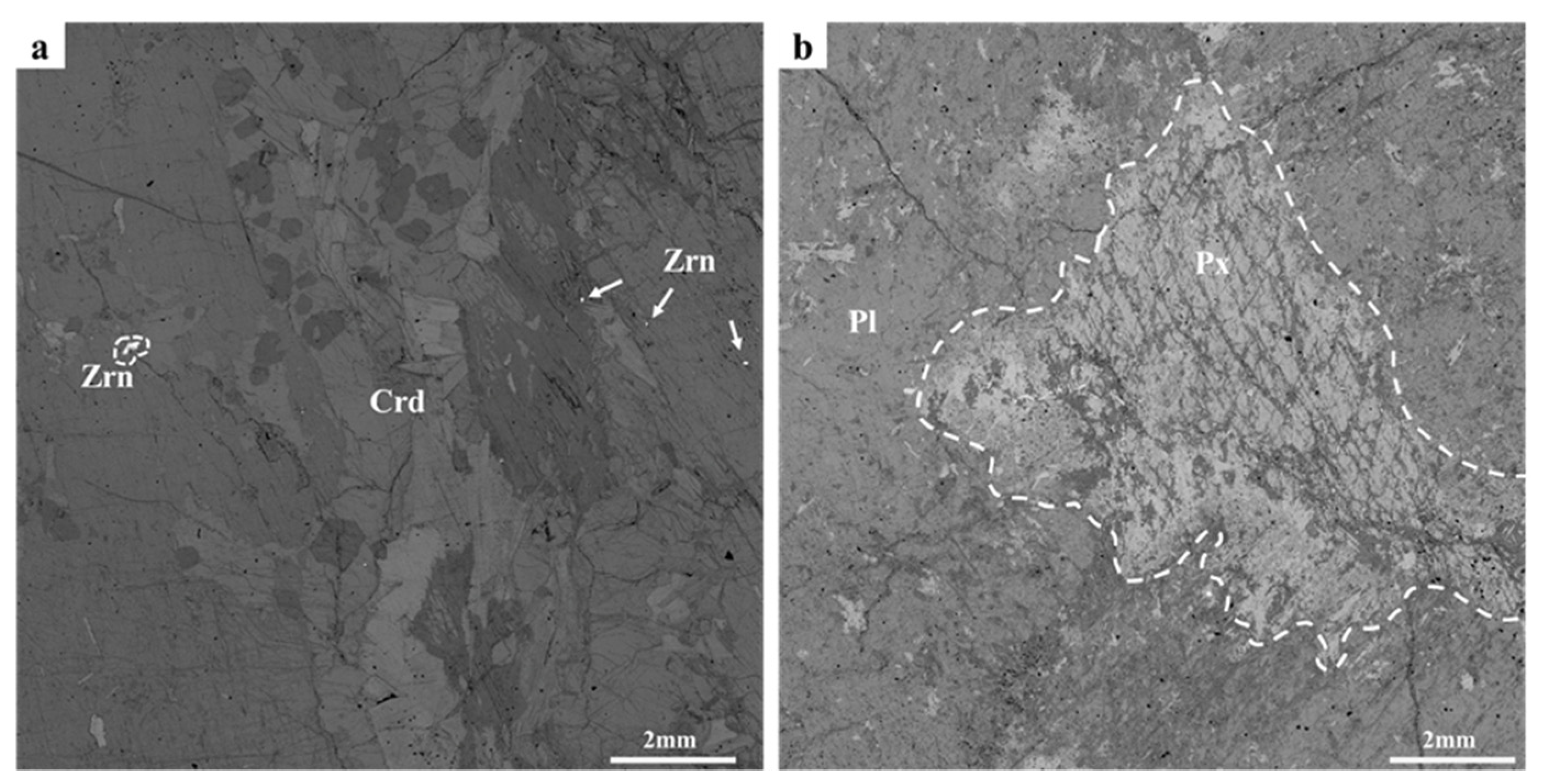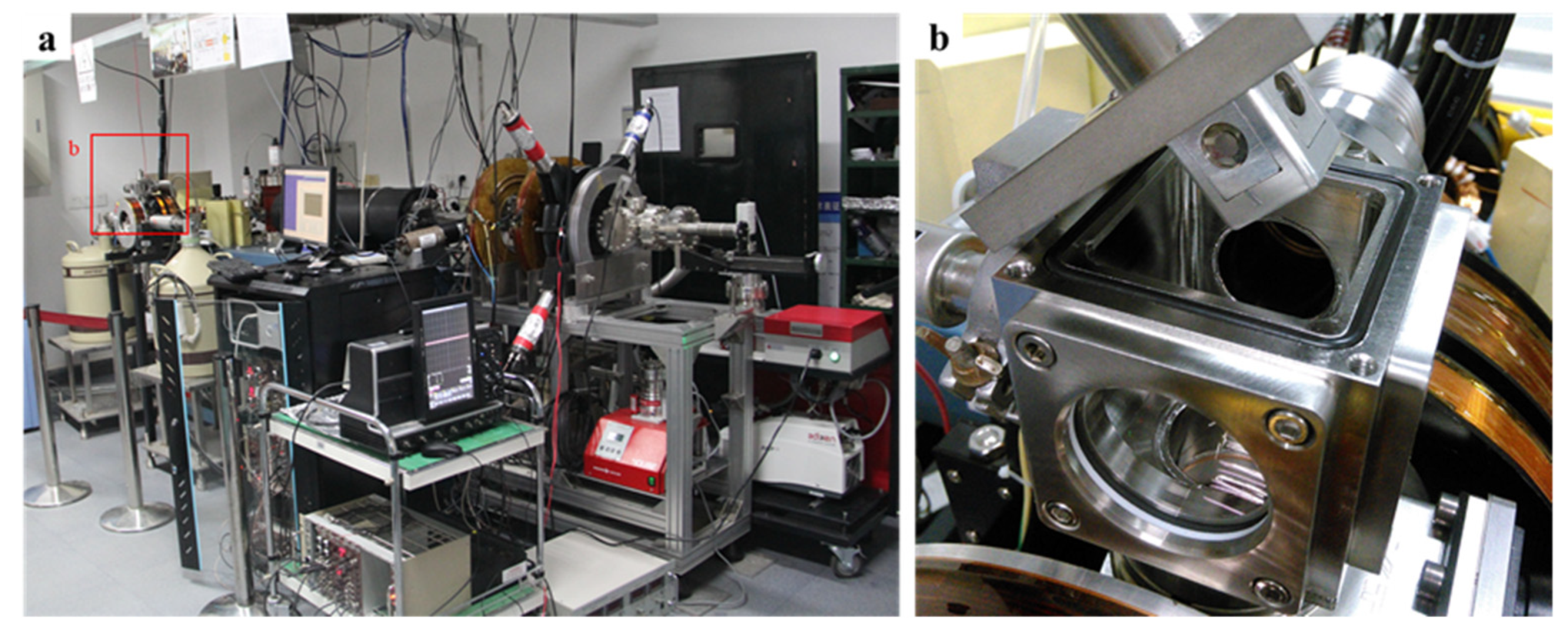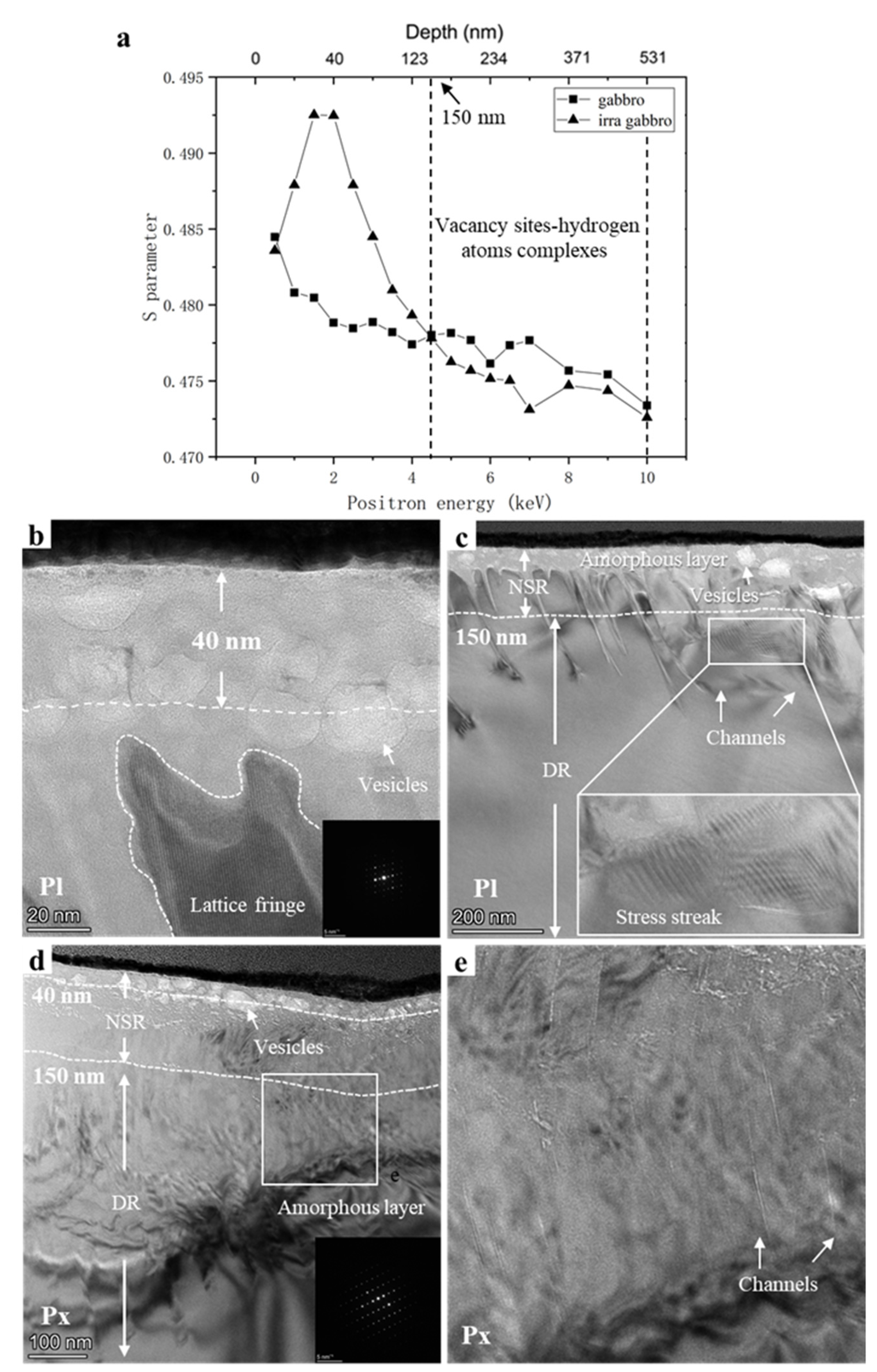Characteristics of Solar Wind Radiation Damage in Lunar Soil: PAT and TEM Study
Abstract
:1. Introduction
2. Materials and Methods
2.1. Sample
2.2. Hydrogen Ion Irradiation
2.3. PAT
2.4. FIB-TEM
3. Results and Discussion
4. Conclusions
Author Contributions
Funding
Data Availability Statement
Acknowledgments
Conflicts of Interest
References
- Keller, L.P.; McKay, D.S. The nature and origin of rims on lunar soil grains. Geochim. Cosmochim. Acta 1997, 61, 2331–2341. [Google Scholar] [CrossRef] [Green Version]
- Noble, S.K.; Keller, L.P.; Pieters, C.M. Evidence of space weathering in regolith breccias I: Lunar regolith breccias. Meteorit. Planet. Sci. 2005, 40, 397–408. [Google Scholar] [CrossRef]
- Bradley, J.P.; Ishii, H.A.; Gillis-Davis, J.J.; Ciston, J.; Nielsen, M.H.; Bechtel, H.A.; Martin, M.C. Detection of solar wind-produced water in irradiated rims on silicate minerals. Proc. Natl. Acad. Sci. USA 2014, 111, 1732–1735. [Google Scholar] [CrossRef] [PubMed] [Green Version]
- Burgess, K.; Stroud, R. Phase-dependent space weathering effects and spectroscopic identification of retained helium in a lunar soil grain. Geochim. Cosmochim. Acta 2018, 224, 64–79. [Google Scholar] [CrossRef]
- Qian, Y.; Xiao, L.; Head, J.W.; van der Bogert, C.H.; Hiesinger, H.; Wilson, L. Young lunar mare basalts in the Chang’e-5 sample return region, northern Oceanus Procellarum. Earth Planet. Sci. Lett. 2021, 555, 116702. [Google Scholar] [CrossRef]
- Li, Q.-L.; Zhou, Q.; Liu, Y.; Xiao, Z.; Lin, Y.; Li, J.-H.; Ma, H.-X.; Tang, G.-Q.; Guo, S.; Tang, X.; et al. Two-billion-year-old volcanism on the Moon from Chang’e-5 basalts. Nature 2021, 600, 54–58. [Google Scholar] [CrossRef] [PubMed]
- Laczniak, D.; Thompson, M.; Christoffersen, R.; Dukes, C.; Clemett, S.; Morris, R.; Keller, L. Characterizing the spectral, microstructural, and chemical effects of solar wind irradiation on the Murchison carbonaceous chondrite through coordinated analyses. Icarus 2021, 364, 114479. [Google Scholar] [CrossRef]
- Harries, D.; Langenhorst, F. The mineralogy and space weathering of a regolith grain from 25143 Itokawa and the possibility of annealed solar wind damage. Earth Planets Space 2014, 66, 163. [Google Scholar] [CrossRef] [Green Version]
- Pelizzo, M.G.; Corso, A.J.; Santi, G.; Hübner, R.; Garoli, D.; Doyle, D.; Lubin, P.; Cohen, A.N.; Erlikhman, J.; Favaro, G.; et al. Dependence of the damage in optical metal/dielectric coatings on the energy of ions in irradiation experiments for space qualification. Sci. Rep. 2021, 11, 1–12. [Google Scholar] [CrossRef]
- Gidley, D.W.; Peng, H.-G.; Vallery, R.S. Positron annihilation as a method to characterize porous materials. Annu. Rev. Mater. Sci. 2006, 36, 49–79. [Google Scholar] [CrossRef] [Green Version]
- Hurwitz, D.M.; Kring, D.A. Differentiation of the South Pole–Aitken basin impact melt sheet: Implications for lunar exploration. J. Geophys. Res. Planets 2014, 119, 1110–1133. [Google Scholar] [CrossRef]
- Marvin, U.B.; Carey, J.W.; Lindstrom, M.M. Cordierite-Spinel Troctolite, a New Magnesium-Rich Lithology from the Lunar Highlands. Science 1989, 243, 925–928. [Google Scholar] [CrossRef]
- Heiken, G.H.; Vaniman, D.T.; French, B.M. Lunar Sourcebook, a User’s Guide to the Moon, 3rd ed.; Cambridge University Press: Cambridge, UK, 1991; pp. 47–55. [Google Scholar]
- Burke, D.; Dukes, C.; Kim, J.-H.; Shi, J.; Fama, M.; Baragiola, R. Solar wind contribution to surficial lunar water: Laboratory investigations. Icarus 2011, 211, 1082–1088. [Google Scholar] [CrossRef]
- Jin, S.; Zhang, P.; Lu, E.; Guo, L.; Wang, B.; Cao, X. Correlation between Cu precipitates and irradiation defects in Fe–Cu model alloys investigated by positron annihilation spectroscopy. Acta Mater. 2016, 103, 658–664. [Google Scholar] [CrossRef]
- Jin, S.; Zhang, P.; Lu, E.; Wang, B.; Yuan, D.; Wei, L.; Cao, X. Effect of annealing on Cu precipitates in H ion irradiated Fe–0.6%Cu studied by positron annihilation. J. Nucl. Mater. 2016, 479, 390–393. [Google Scholar] [CrossRef]
- Zhang, P.; Jin, S.; Lu, E.; Wang, B.; Zheng, Y.; Yuan, D.; Cao, X. Effect of annealing on VmHn complexes in hydrogen ion irradiated Fe and Fe–0.3% Cu alloys. J. Nucl. Mater. 2015, 459, 301–305. [Google Scholar] [CrossRef]
- Mirzaev, D.A.; Mirzoev, A.A.; Okishev, K.Y.; Verkhovykh, A.V. Hydrogen–vacancy interaction in bcc iron: ab initio calculations and thermodynamics. Mol. Phys. 2014, 112, 1745–1754. [Google Scholar] [CrossRef]
- Fujinami, M.; Suzuki, R.; Ohdaira, T.; Mikado, T. Thermal evolution of defects in H-implanted Si studied by monoenergetic positrons. Phys. Rev. B 1998, 58, 12559–12562. [Google Scholar] [CrossRef]
- Zeng, X.; Tang, H.; Li, X.; Zeng, X.; Yu, W.; Liu, J.; Zou, Y. Experimental investigation of OH/H2O in H+-irradiated plagioclase: Implications for the thermal stability of water on the lunar surface. EPSL 2021, 560, 116806. [Google Scholar] [CrossRef]
- Zhao, S. Crystallography and Mineralogy, 21st ed.; Geological Publishing House: Beijing, China, 2001; pp. 310–398. [Google Scholar]
- Uedono, A.; Shimayama, K.; Kiyohara, M.; Chen, Z.Q.; Yamabe, K. Study of oxygen vacancies in SrTiO3 by positron annihilation. J. Appl. Phys. 2002, 92, 2697–2702. [Google Scholar] [CrossRef]
- Uedono, A.; Koida, T.; Tsukazaki, A.; Kawasaki, M.; Chen, Z.Q.; Chichibu, S.; Koinuma, H. Defects in ZnO thin films grown on ScAlMgO4 substrates probed by a monoenergetic positron beam. J. Appl. Phys. 2003, 93, 2481–2485. [Google Scholar] [CrossRef]
- He, S.M.; Van Dijk, N.H.; Schut, H.; Peekstok, E.R.; Van Der Zwaag, S. Thermally activated precipitation at defor-mation-induced defects in Fe-Cu and Fe-Cu-BN alloys studied by positron annihilation spectroscopy. Phys. Rev. B 2010, 81, 094103. [Google Scholar] [CrossRef] [Green Version]






| Amorphous Layer | Vesicles | Channels Effect | Stress Stripe | |
|---|---|---|---|---|
| Plagioclase | Avg. ~300 nm | Avg. ~20 nm, Max. ~200 nm | Multiple Length < 600 nm Width < 5 nm | Yes, multiple |
| Pyroxene | Avg. ~400 nm | Avg. ~20 nm, Max. ~90 nm | Less Length < 100 nm Width < 1 nm | Yes, less |
| Cordierite | Avg. ~85 nm | Avg. ~20 nm, Max. ~90 nm | Tiny Length < 100 nm Width < 1 nm | No |
Publisher’s Note: MDPI stays neutral with regard to jurisdictional claims in published maps and institutional affiliations. |
© 2022 by the authors. Licensee MDPI, Basel, Switzerland. This article is an open access article distributed under the terms and conditions of the Creative Commons Attribution (CC BY) license (https://creativecommons.org/licenses/by/4.0/).
Share and Cite
Zhao, S.; Chen, H.; Li, Y.; Jin, S.; Wu, Y.; Zhou, C.; Li, X.; Tang, H.; Yu, W.; Xia, Z. Characteristics of Solar Wind Radiation Damage in Lunar Soil: PAT and TEM Study. Nanomaterials 2022, 12, 1135. https://doi.org/10.3390/nano12071135
Zhao S, Chen H, Li Y, Jin S, Wu Y, Zhou C, Li X, Tang H, Yu W, Xia Z. Characteristics of Solar Wind Radiation Damage in Lunar Soil: PAT and TEM Study. Nanomaterials. 2022; 12(7):1135. https://doi.org/10.3390/nano12071135
Chicago/Turabian StyleZhao, Sizhe, Hongyi Chen, Yang Li, Shuoxue Jin, Yanxue Wu, Chuanjiao Zhou, Xiongyao Li, Hong Tang, Wen Yu, and Zhipeng Xia. 2022. "Characteristics of Solar Wind Radiation Damage in Lunar Soil: PAT and TEM Study" Nanomaterials 12, no. 7: 1135. https://doi.org/10.3390/nano12071135






